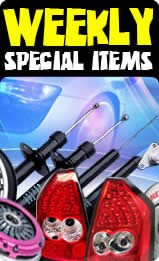Chevy Cavalier Lowering Springs, Suspension Lowering Kit at TunersDepot
Chevy Cavalier lowering springs can be a great way to increase the suspension on your Cavalier. Lowering Springs are designed to lower the ride height for a lower center of gravity, faster turning, and overall suspension performance improvement. In addition, the lower stance gives your Chevy Cavalier a MUCH nicer look, as it detracts from the “on stilts” look in favor of accenting the length and curves of your Cavalier’s body.
Our line of Chevy Cavalier lowering springs carry thru 1995, 1996, 1997, 1998, 1999, 2000, 2001, 2002, 2003, 2004 or 95, 96, 97, 98, 99, 00, 01, 02, 03, 04 models.
95-04 Cavalier Lowering Springs
Chevy Cavalier Lowering Spring Installation FAQ
Can I install your lowering springs onto my Cavalier by myself?
We highly recommend professional installation. Especially if you still have stock springs on your vehicle, special equipment may be needed to compress the springs during installation. Installation on most cars should run about $40-150.00 at a professional shop.Is there anything I should do after installing springs onto my Chevy Cavalier?
Yes! As is the case when you change wheels, get new shocks, etc., we HIGHLY encourage you to get an alignment as the lowering springs will change the entire suspension characteristics of your vehicle. Additionally, it is rather easy to disrupt the alignment of your vehicle during installation.Will I need a camber kit after I install these lowering springs?
Assuming the rest of your vehicle is stock, you should not need a camber kit if you are using standard or OE drop springs. For race springs, they MIGHT be required, but the best way to tell is to look at your tires. They should be at a near perpendicular angle to the road. If they are butterflying, that is, the tops leaning inward, and the bottoms leaning outward, then you should get a camber kit installed right away and get an alignment.I installed these springs and my car did not get lowered to the listed height… what gives?
Please allow a month for your springs to “settle” into your vehicle. Until that time, you will not see the target height of the springs. Also, please keep in mind that the height change is meant for your OEM setup. If you have worn or aftermarket wheels, shocks, etc., the height may be different. In addition, if you travel with an unusually large amount of weight in the vehicle while driving, you will likewise experience a lower than expected drop.I installed your springs into my Chevy Cavalier but I still want my car lower. Any suggestions?
Usually, installing a set of aftermarket performance shocks such as Tokico can give you an extra 0.5inch of drop height after settling. Additionally, ground effects, especially lip kits can reduce the appearance of empty space beneath your vehicle giving the impression of being lower. Also, wheel size is another important consideration to take into effect when it comes to either lowering the vehicle or filling up the wheel well.Drivability and General FAQ
How many springs come in this set?
99.9% of the time, a set will come with 4 springs. Basically, aftermarket springs will contain the same amount of springs that your stock has. In SUPER rare occasions, ride height is handled by something other than springs (like the original Acura Integra for instance), so the set will only contain 2 springs. Unless noted though, almost all of our springs come with all 4 springs: 2 fronts and 2 rears.How will my Chevy Cavalier ride on these springs?
As far as ride and performance, Eibach and H&R pretty much kick the crap out of most other spring brands out there, and clobber heated or ‘’cut’’ springs. Between the 2 though, H&R offers a softer smoother ride, while Eibach offers stiffer better performance.What do you mean ‘’cut’’ springs?
DON’T DO IT! In the early days, people use to literally CUT their stock or aftermarket springs in order to get an extremely low drop, or to put it in the terms of the day, to “slam” their car. This is a horrible idea though as the ride will be bouncy, rough, and literally a pain in the you-know-what. Likewise, people also use to heat their springs (though torch might be more accurate term) for similar horrible effect.Are these springs progressive? And while we are at it, what does progressive mean anyway?
Most springs nowadays are progressive. This means that the design of the spring is not equal throughout the length of it. Rather, some parts are smaller and closer coiled, and some are larger and farther coiled. This allows for the MAXIMUM absorption and rebound for the given spring length. If you see a set of springs and all 4 springs and space between coils are exactly identical, then it is probably not a progressive set of springs.Are these springs legal?
Assuming that the rest of the suspension setup on your Cavalier is either stock or not overly aggressive, then you should have no problems with the law. Though some areas have regulations regarding how low your Cavalier could be to the ground, the springs we offer should not be enough to push you over the edge. To be safe though, please check with your local laws and measure the distance on the bottom of your vehicle before purchasing.How do I "angle" my Chevy Cavalier to avoid scraping my severely lowered Cavalier?
On the off chance that you are running extremely small wheels, have a super low body kit, or have 4 linebackers and a trunk full of lead in your car, you may sometimes find it necessary to ‘’angle’’ your car to avoid scraping on speedbumps and getting into driveways. Though you really should never let your Cavalier get this low in the first place, the trick is to get one tire to touch the bump/driveway at a time, trying to change the seesaw point from the front to back sides of your car to the shorter left to right orientation. The motion involves turning one way to approach the obstacle at an angle, then turning the other way to clear the rest of your car, then straightening back out.The art of lowered vehicle "Angling"
- Make sure no one is behind you or coming at you from the opposite direction, and that it is safe and legal to angle.
- Instead of approaching the driveway or bump head on, approach it at an angle (45 to 135 degrees) so that only one of your front tire engages and clears it.
- If space allows it, continue on this path to clear the other front tire. Afterwards, or if there was not enough space to clear the second tire, turn your vehicle 90 degrees in the opposite direction in order to begin approaching from the opposite angle.
- Keep the vehicle at such an angle that as close as possible, only one tire traverses the bump/driveway at a time.
- Repeat as necessary.
- Watch the road Potholes, dips, and gigantic pieces of debris are your enemy.
- Know your route In any given plaza, there will usually be one driveway or path which is at a flatter angle or is clearer of speedbumps. Learn these paths and commit them to memory.
- Keep your tires in mind Proper inflation is key to keeping your bumper and chassis scrape free. Also, where possible, go with a larger series of tire to give extra distance between you and the road.
- Slower equals better Taking a bump or driveway fast will increase the amount of bounce your car experiences, thus increasing damage. The slower you take it, the less rebound, and the less likely you are to end up with sparks flying or pieces of your bumper getting left behind.
- Minimize your load If any bump ever looks TOO bad, tell your girlfriend and linebacker buddies to take a hike until you clear the obstacle. The lighter your car, the less likely you are to paint the speedbump with the bottom of your Cavalier.



















